PHRA NAKHON SI AYUTTHAYA, Thailand -- Before a brutal Burmese invasion in the late 18th century, the city of Ayutthaya, the second capital of the Siamese Kingdom for four centuries, was a grand Buddhist city where international trade and art prospered. Its population rivaled that of contemporary London or Paris in its prime.
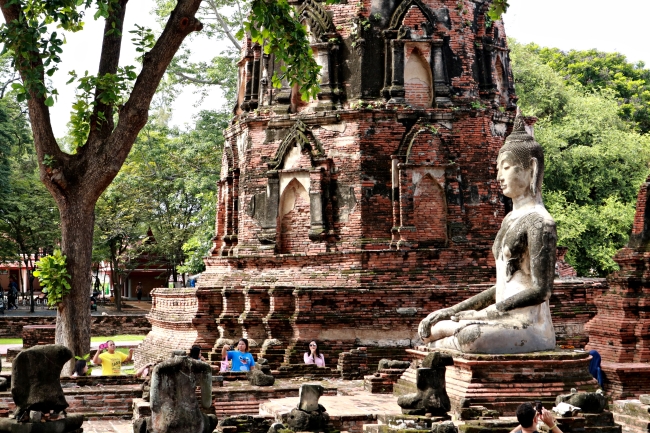
Buddhist temples and royal relics were strewn across the capital city of Ayutthaya Kingdom, surrounded by three rivers -- Chao Phraya, Lopburi and Pa Sak -- that connect the city to the Gulf of Thailand. Founded in 1351, the city invited foreign elements from not only adjacent Southeast Asian countries, but also far-off nations including India, China, Japan and France, forming a harmonious whole.
But the “unstoppable Burmese military machine,” as described in “The River of Lost Footsteps: Histories of Burma” authored by Burmese historian Thant Myint-U, sacked the largest city in central Thailand that had weathered dozens of previous Burmese offenses.
Besieged, the city was reduced to rubble in 1767. Temples and surrounding red brick-and-mortar walls fell into pieces, and stone Buddha statues were decapitated. Burmese troops looted gold and relics from the temples and set the city on fire. Borommaracha III, the last king, starved to death a few days after he fled home. Fifteen years later, a new kingdom called Rattanakosin established a new capital in Bangkok.
Centuries later, vestiges of the magnificence of the fallen city, some 80 kilometers north of Bangkok, remains to this day.
But the “unstoppable Burmese military machine,” as described in “The River of Lost Footsteps: Histories of Burma” authored by Burmese historian Thant Myint-U, sacked the largest city in central Thailand that had weathered dozens of previous Burmese offenses.
Besieged, the city was reduced to rubble in 1767. Temples and surrounding red brick-and-mortar walls fell into pieces, and stone Buddha statues were decapitated. Burmese troops looted gold and relics from the temples and set the city on fire. Borommaracha III, the last king, starved to death a few days after he fled home. Fifteen years later, a new kingdom called Rattanakosin established a new capital in Bangkok.
Centuries later, vestiges of the magnificence of the fallen city, some 80 kilometers north of Bangkok, remains to this day.
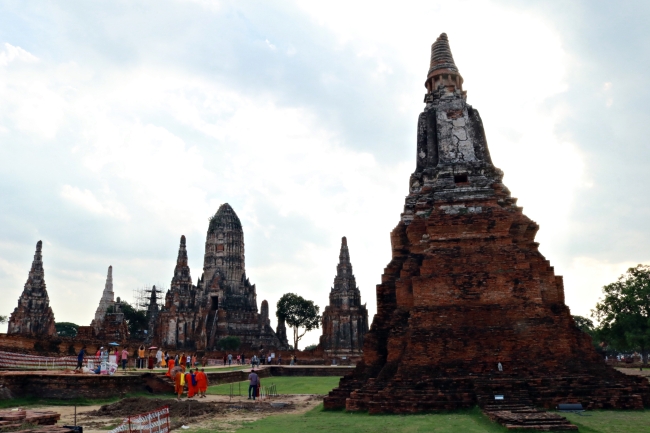
Inside temple complexes, numerous structures like stupas -- relic-containing pagodas also called “chedi” -- and conical towers -- locally dubbed “prang” -- loom over visitors, offering a glimpse of the cosmopolitan city’s past glory.
Meanwhile, collapsed brick walls and crumbled bricks near walls at the foot of stupas are left untouched. Bodies of headless stone Buddha statues sit along the wall.
Ruins in Ayutthaya like Wat Mahathat, Wat Ratchaburana and Wat Chai Wattanaram were left abandoned for two centuries after the kingdom’s downfall. Chunks of the walls surrounding the temple and the city were removed and sent to cities like Bangkok for the sake of construction. They have also been exposed to threats like floods or urban development, as well as lootings.
For instance, Wat Ratchaburana’s crypt made in honor of King Borommarachathirat II’s two elder brothers was looted of Buddha images and gold artifacts in 1957. Some treasures inside the prang were retrieved and exhibited in the nearby Chao Sam Phraya National Museum.
The Thai government has made efforts to preserve historical assets since the late 20th century. The Thai Fine Arts Department of the Culture Ministry embarked on renovations of the ruins in 1969, followed by the designation of Ayutthaya Historical Park in 1976, and its recognition as a UNESCO World Heritage Site in 1991. The site is currently protected by Thai law, including the Act on Ancient Monuments, Antiques, Objects of Art and National Museums.
Meanwhile, collapsed brick walls and crumbled bricks near walls at the foot of stupas are left untouched. Bodies of headless stone Buddha statues sit along the wall.
Ruins in Ayutthaya like Wat Mahathat, Wat Ratchaburana and Wat Chai Wattanaram were left abandoned for two centuries after the kingdom’s downfall. Chunks of the walls surrounding the temple and the city were removed and sent to cities like Bangkok for the sake of construction. They have also been exposed to threats like floods or urban development, as well as lootings.
For instance, Wat Ratchaburana’s crypt made in honor of King Borommarachathirat II’s two elder brothers was looted of Buddha images and gold artifacts in 1957. Some treasures inside the prang were retrieved and exhibited in the nearby Chao Sam Phraya National Museum.
The Thai government has made efforts to preserve historical assets since the late 20th century. The Thai Fine Arts Department of the Culture Ministry embarked on renovations of the ruins in 1969, followed by the designation of Ayutthaya Historical Park in 1976, and its recognition as a UNESCO World Heritage Site in 1991. The site is currently protected by Thai law, including the Act on Ancient Monuments, Antiques, Objects of Art and National Museums.
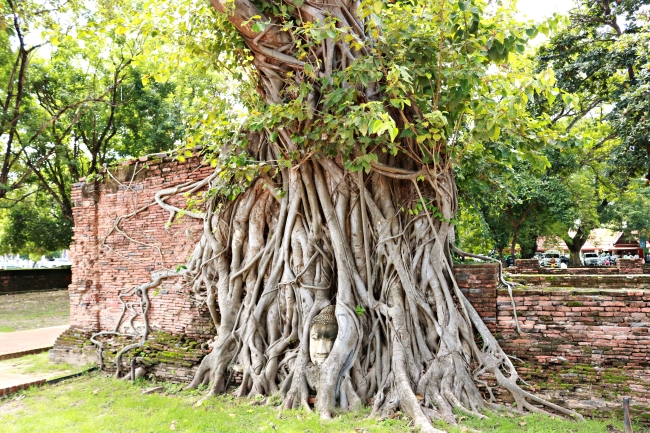
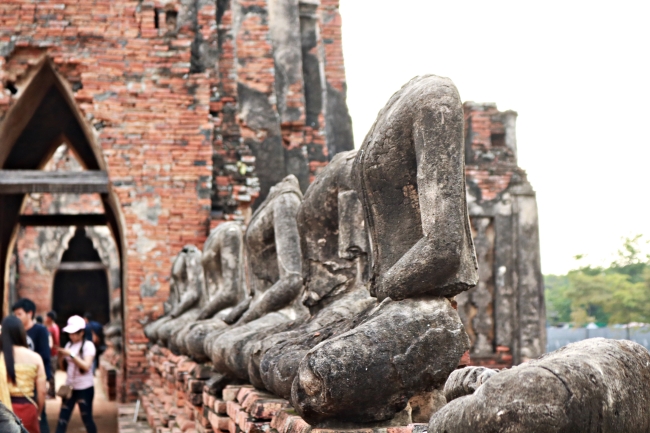
The intrinsic value of the artifacts comes from the fact that they exhibit influences from adjacent countries such as Burma and Khmer alongside the kingdom’s precursor Sukhothai. Signs of international trade back when Ayutthaya Kingdom was at its peak are also evident, experts told participants of a recent ASEAN + 3 new media familiarization trip hosted by the Thai Foreign Ministry.
Influenced by the architecture of Khmer towers, some stupas in Wat Mahathat, Wat Ratchaburana and Wat Chai Wattanaram, built in the 14th, 15th and 18th centuries, respectively, became “elongated.”
“We can say that Thailand during the Ayutthaya period tried to follow the ideology of the Khmer Empire,” said Chedha Tingsanchali, an associate professor of art history at Silpakorn University.
Worn-out frescos inside the large prang of Wat Ratchaburana are also proof of Burmese influence, Tingsanchali added. He cited its similarity with murals found in the ancient Burmese city of Bagan, which depict multiple Buddhas on a wall divided into squares in a red tone.
Influenced by the architecture of Khmer towers, some stupas in Wat Mahathat, Wat Ratchaburana and Wat Chai Wattanaram, built in the 14th, 15th and 18th centuries, respectively, became “elongated.”
“We can say that Thailand during the Ayutthaya period tried to follow the ideology of the Khmer Empire,” said Chedha Tingsanchali, an associate professor of art history at Silpakorn University.
Worn-out frescos inside the large prang of Wat Ratchaburana are also proof of Burmese influence, Tingsanchali added. He cited its similarity with murals found in the ancient Burmese city of Bagan, which depict multiple Buddhas on a wall divided into squares in a red tone.
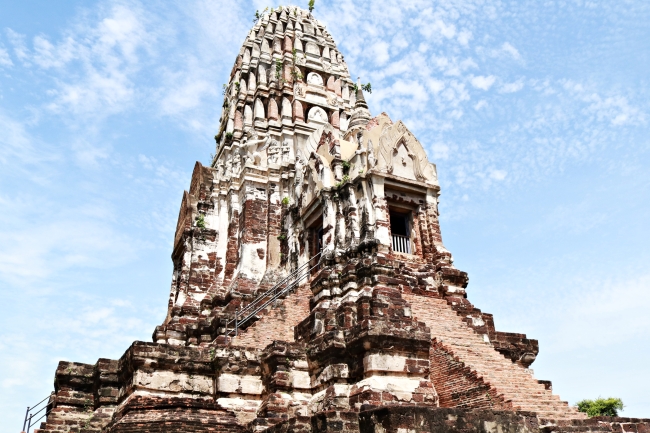
Other than the artistic features, traces that Ayutthaya was once a melting pot can be observed in the park.
For instance, Wat Ratchaburana’s crypt was found to have housed ancient gold coins of Sultan Zain al-Abidin made in the Muslim kingdom, Samudra Pasai, indicating Ayutthaya’s trade with the sultanate located on the northern coast of Sumatra Island.
Ayutthaya Kingdom’s capital city embraced the Muslim community comprising immigrants from Gujarat, Persia, Arabia, Makassar, Java and Malay. Along with migrated Burmese, Mons, Laos, Vietnamese and Khmers, they were given citizenship by the kingdom.
Some of their descendants still live near the old city. Takiayokhin Mosque, located across the Chao Phraya River less than 5 kilometers south of the historical park, was first built in the 16th century and refurbished during the Rattanakosin period. The place now serves as not only a pilgrimage destination but also public kitchens for Muslim residents nearby.
Arriving at Phra Nakhon Si Ayutthaya Province by airplane or train, visitors can tour the Ayutthaya Historical Park on foot or by bicycles for a couple of days.
For instance, Wat Ratchaburana’s crypt was found to have housed ancient gold coins of Sultan Zain al-Abidin made in the Muslim kingdom, Samudra Pasai, indicating Ayutthaya’s trade with the sultanate located on the northern coast of Sumatra Island.
Ayutthaya Kingdom’s capital city embraced the Muslim community comprising immigrants from Gujarat, Persia, Arabia, Makassar, Java and Malay. Along with migrated Burmese, Mons, Laos, Vietnamese and Khmers, they were given citizenship by the kingdom.
Some of their descendants still live near the old city. Takiayokhin Mosque, located across the Chao Phraya River less than 5 kilometers south of the historical park, was first built in the 16th century and refurbished during the Rattanakosin period. The place now serves as not only a pilgrimage destination but also public kitchens for Muslim residents nearby.
Arriving at Phra Nakhon Si Ayutthaya Province by airplane or train, visitors can tour the Ayutthaya Historical Park on foot or by bicycles for a couple of days.
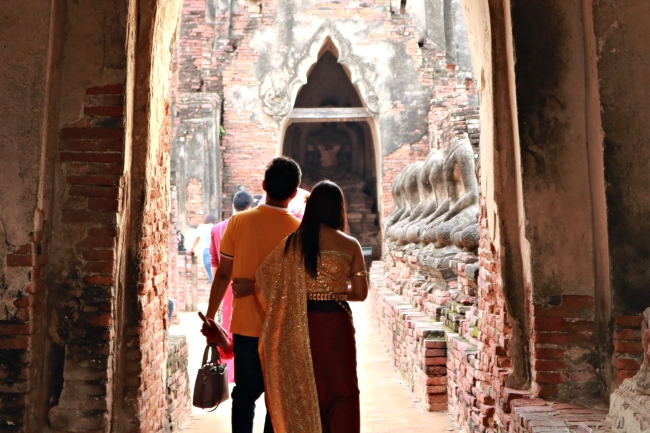







![[KH Explains] Hyundai's full hybrid edge to pay off amid slow transition to pure EVs](http://res.heraldm.com/phpwas/restmb_idxmake.php?idx=644&simg=/content/image/2024/04/18/20240418050645_0.jpg&u=20240419100350)







![[From the Scene] Monks, Buddhists hail return of remains of Buddhas](http://res.heraldm.com/phpwas/restmb_idxmake.php?idx=652&simg=/content/image/2024/04/19/20240419050617_0.jpg&u=20240419175937)

![[KH Explains] Hyundai's full hybrid edge to pay off amid slow transition to pure EVs](http://res.heraldm.com/phpwas/restmb_idxmake.php?idx=652&simg=/content/image/2024/04/18/20240418050645_0.jpg&u=20240419100350)

![[Today’s K-pop] Illit drops debut single remix](http://res.heraldm.com/phpwas/restmb_idxmake.php?idx=642&simg=/content/image/2024/04/19/20240419050612_0.jpg&u=)